Hype, Infra, Adoption: Will x402 Make it?
Original article by: 100y.eth, Four Pillars
Original translation: Saoirse, Foresight News
Key Points
In the cryptocurrency industry, most new concepts go through three stages: hype, infrastructure construction, and application popularization. However, most concepts fail to successfully transition from the hype stage to the infrastructure stage and eventually lose market attention.
- x402 is a payment protocol for artificial intelligence (AI) agents developed by Coinbase that enables AI agents to autonomously complete payments and obtain paid resources through the blockchain without human intervention.
- Judging from the recent surge in the prices of x402-related tokens, the protocol has entered a hype phase; but unlike other crypto concepts, giants such as Cloudflare, Google Cloud, and Anthropic are actively adopting x402, and its infrastructure construction phase is progressing rapidly.
- Given the potential of agent-based commerce, the x402 is likely to enter the application phase, but the bottleneck lies in shifting consumer psychology and trust systems. Accenture data shows that the biggest obstacle to the large-scale adoption of agent-based commerce is consumer distrust of AI agents.
- However, Gartner predicts that by 2030, transaction volume driven by AI agents will reach $30 trillion, making AI commerce an inevitable and massive market. By then, the blockchain industry will have found its second global "product-market fit" (PMF) after stablecoins, through x402.
The Hype, Infrastructure, and Adoption Cycle
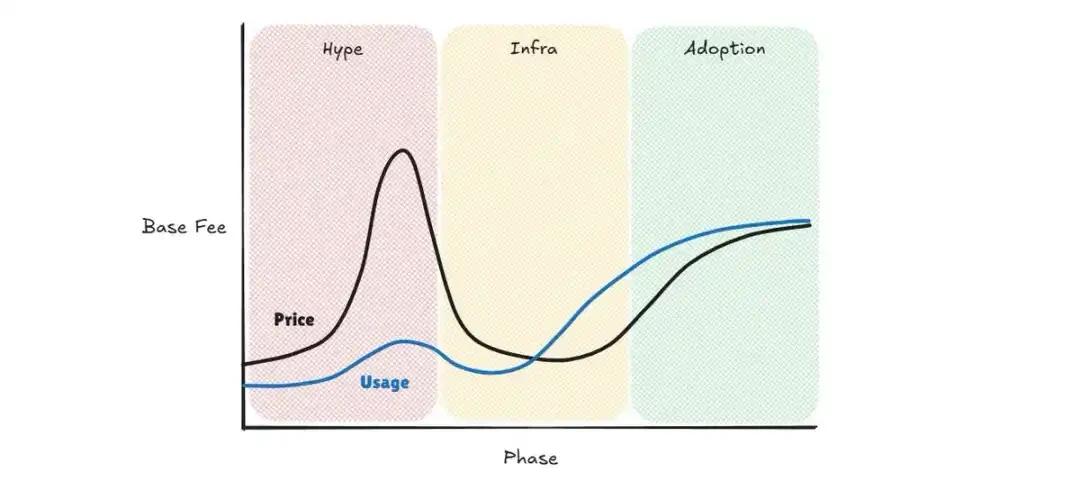
A new concept of "survival test"
The cryptocurrency industry is rapidly changing, with new concepts often experiencing a rise and fall cycle of less than a few months. This burgeoning and waning of attention far surpasses other industries. From a broader perspective, popular concepts like NFTs, gaming, the metaverse, and modular blockchains have all experienced this pattern. On a smaller scale, the recent "futarchy" phenomenon is a prime example: a brief surge before a rapid fading from market attention.
As new concepts emerge constantly in the crypto industry, a concept needs to overcome multiple obstacles to achieve true "application landing." I summarize this process into three stages:
- Hype Phase: The period when a new concept first gains widespread attention. During this phase, prices of existing projects, small, newly launched projects, and even related meme tokens, even those only tenuously related to the concept, often surge by tens or even hundreds of percent. If the concept successfully transitions to the next phase, prices may remain stable; however, in most cases, prices plummet within weeks or months, and the associated project disappears.
- Infrastructure Stage: Once a new concept's potential and practicality have been proven, developers begin developing products based on it that deliver real value. Product development takes a long time (ranging from several months to over a year), so vague and weak concepts often die during this stage. However, truly meaningful concepts maintain steady attention and create real-world applications during this stage, leading to the gradual growth of the entire field.
- Application Stage: Concepts that reach this stage are incredibly rare! In the crypto space, only a handful of concepts have reached this stage, including automated market makers (AMMs), central limit order books (CLOBs), lending protocols, staking protocols, and stablecoins. Concepts that reach the application stage have demonstrated product-market fit (PMF), and new protocols will continue to emerge, attracting significant user participation.
Typical cases in the encryption industry
So, what stage are the hot topics that have attracted much attention on crypto social platforms recently at?
- Futarchy: As mentioned above, predictive governance initially gained traction due to Vitalik Buterin's mention of it, but the hype subsequently faded. It recently saw a brief resurgence thanks to Solana's ICO, but within a few weeks, it fell out of favor again. The core reason for this is that predictive governance involves a complex governance system, making it difficult to achieve large-scale application without a multi-generational shift in human thinking.
- Decentralized energy: Decentralized energy entered a hype phase last year as several companies secured investment from top-tier venture capital firms. Recently, Daylight secured $75 million in funding from Framework and a16zcrypto, briefly igniting market enthusiasm, but the attention was short-lived. Fundamentally, decentralized energy is a field that requires physical infrastructure, and its construction phase is inherently time-consuming.
- Robotics (Crypto x Robotics): The development path of robotics is similar to the aforementioned case. At the height of the "crypto + AI" hype, the "crypto + robotics" project Openmind raised $20 million from institutions such as Pantera, igniting market interest in robotics. Since then, the prices of numerous small and medium-sized projects and meme coins have skyrocketed, but reaching the application stage will still take time. However, given the enormous potential of the "crypto + robotics" concept, many developers, including Openmind, are actively pursuing product development.
These cases show that in the encryption industry, it is extremely difficult for a new concept to go from "birth" to "application implementation."
However, the x402 protocol, which has recently gained popularity on crypto social platforms, seems poised to quickly break this "curse" and smoothly enter the application stage. So, what exactly makes x402 so special?
Can the x402 protocol succeed?
x402 Protocol Overview
The x402 protocol is an open payment protocol developed by Coinbase. Its core function is to enable AI agents to autonomously complete payments and transactions without human intervention. Through x402, AI agents can pay for services on multiple blockchain networks using stablecoins, with the advantage of instant settlement, eliminating the complex processes of account registration, subscription activation, and API key configuration.
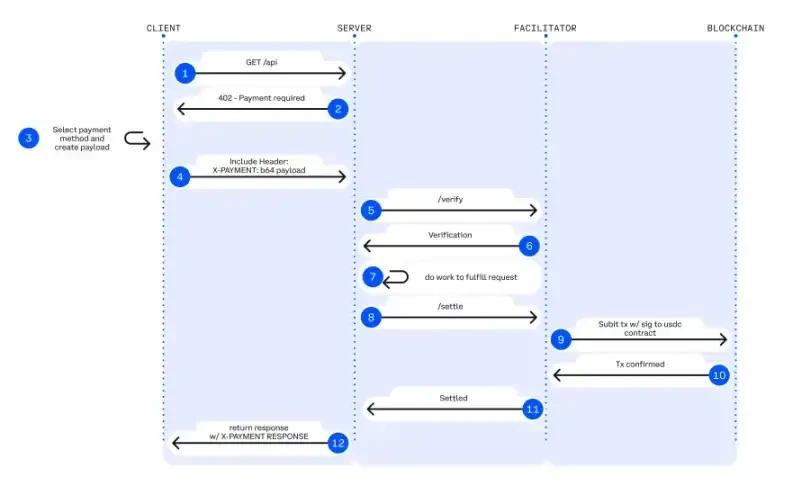
Source: Coinbase
HTTP 402 is a network status code indicating "payment required," but it has long been rarely used in practice. The x402 protocol exploits this status code: when an AI agent sends an API request, the server returns an HTTP 402 status code with the message "payment required to continue." The AI agent recognizes this message and automatically pays the corresponding fee in stablecoins. The specific process is as follows:
1. When an AI agent attempts to access paid services such as news, APIs, and data, the server will return an "HTTP 402 Payment Required" status code. This response not only includes a "Payment Required" notification but also includes key information such as the payment method, payment amount, and recipient's wallet address.
2. The AI agent generates a transaction with the corresponding amount based on the information provided by the server, adds a digital signature, and sends it back to the server.
3. The server passes the transaction to the Facilitator, who verifies the payment and completes the transaction on the blockchain.
4. After payment is completed, the server will open access to the paid service to the AI agent.
The value of x402 goes far beyond simply providing a payment standard for AI agents. Because payments are made using a blockchain-based stablecoin, it enables previously unattainable micropayments. AI agents can call APIs or pay for services in real time based on actual usage. Simultaneously, human users can access content directly through micropayments, bypassing complex steps like API key management and account registration.
Has entered the hype stage

Source: a16zcrypto
Launched in May 2025, the x402 protocol initially garnered only moderate attention. However, after being mentioned in a16z's report, "The State of Cryptocurrency 2025: The Year Crypto Goes Mainstream," the protocol's popularity surged. Gartner predicts that the intelligent commerce market will reach $30 trillion by 2030, and a16z notes that x402 has the potential to become a core payment channel for AI agents.
The most direct sign that x402 has entered a hype phase is the surge in the prices of related tokens. For example, $VIRTUAL, a token that tends to rise in tandem with the rise of the "AI agent" concept, saw a 40% increase in just two days. Other related tokens also saw significant increases, as shown in the chart below.
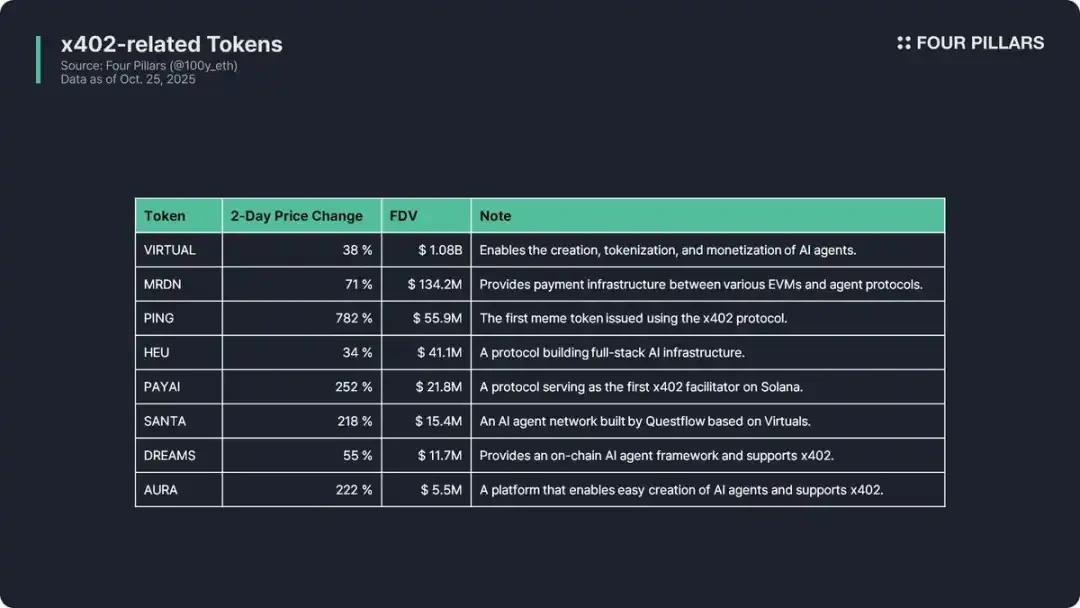
On the surface, x402 appears to be no different from other hype-fueled crypto concepts—empty, superficial, and driven solely by market hype. Indeed, many new crypto concepts follow this path: small projects and meme coins experience skyrocketing prices, only to quickly fade into obscurity.
However, x402 differs fundamentally from these concepts. First, "AI-powered payments" is not only highly relevant in the crypto space but also holds real value across the AI industry, making it a promising topic. Second, numerous Web2 companies are actively pursuing and adopting x402. These factors suggest that x402 will likely transition quickly from hype to infrastructure development rather than lingering in the long term.
Infrastructure construction phase is in progress
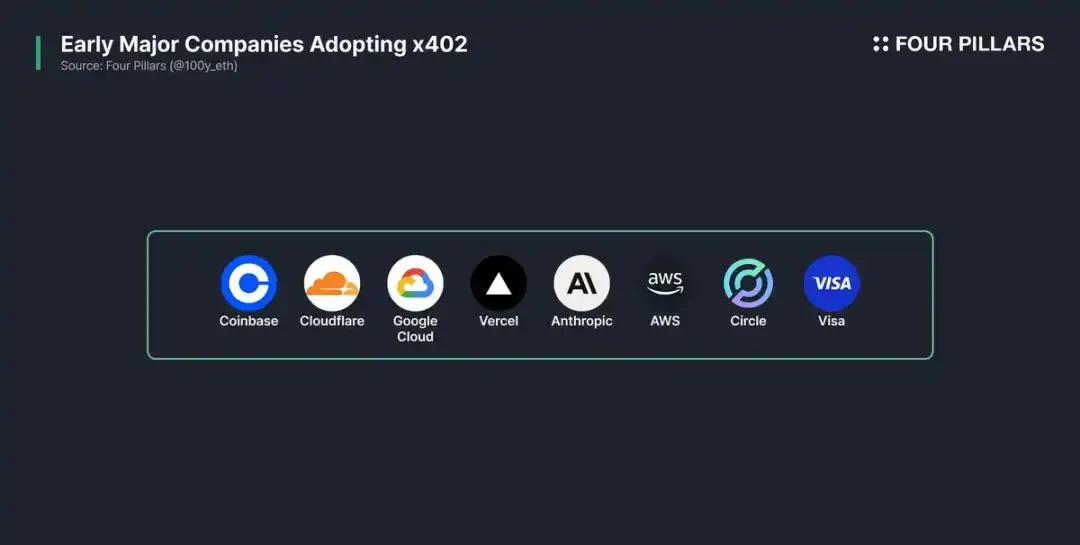
Currently, the x402 protocol is in both the "hype phase" and the "infrastructure phase." In fact, even before the hype phase, numerous Web2 and Web3 companies had already begun building infrastructure for x402 and integrating it into their own services. Therefore, it's more accurate to say that x402 started in the "infrastructure phase."
Interestingly, unlike typical encryption concepts, x402 has attracted the attention of many Web2 technology giants, and these companies have begun to actually adopt the protocol.
Cloudflare
Cloudflare is a company that provides Internet infrastructure and security solutions. It recently launched services such as "Agents SDK" (to help developers quickly create and deploy AI agents) and "Workers AI" (AI model reasoning runtime environment).
Cloudflare and Coinbase jointly launched the x402 Foundation, which is very active in the x402 ecosystem. Its Agents SDK service has integrated the x402 protocol, enabling AI agents to easily complete payments over the internet.
Notably, Cloudflare recently launched the "NET Dollar," a USD-denominated stablecoin designed specifically for AI agents. In the future, AI agents developed using the "Agents SDK" will be able to conduct commerce activities with the NET Dollar via the x402 protocol.
Vercel
Vercel is a cloud platform company that helps developers quickly build and deploy web applications. Recently, Vercel launched services such as the Vercel AI SDK and Vercel MCP. The former makes it easier for developers to build and deploy AI agents, while the latter enables access to projects through the MCP interface. In September 2025, Vercel released the x402-mcp tool, which enables AI agents to automatically complete payments using x402 when accessing paid APIs or resources through MCP.
Google Cloud
Google Cloud previously launched the A2A protocol (AI Agent Communication and Collaboration Protocol), which includes an extension module called AP2 (Agent Payment Protocol) to support autonomous payments by AI agents. The x402 protocol has been integrated into this system, serving as the payment engine that enables AI agents to complete transactions.
Anthropic
Anthropic, a well-known AI company, has developed the Claude Large Language Model (LLM), which allows users to build AI agent services. Anthropic has also launched an open-source standard called "MCP," which defines the rules for AI models to access external tools and data. Claude MCP now supports the x402 protocol, meaning that Claude can automatically complete payments when accessing paid MCP tools.
Visa
Visa, the world's largest credit card payment network, recently announced a joint development with Cloudflare of a "Trusted Proxy Protocol." This protocol verifies the credibility of AI requests in intelligent commerce and supports payment via the x402 protocol.
Other participants
According to the Coinbase announcement, Circle, AWS and other companies are also working with the x402 protocol.
In addition to support at the enterprise and protocol levels, developer-focused tools are also emerging, such as x402scan. This browser tool visualizes x402-enabled servers, transaction history, and payment flows, helping users clearly understand which services, through which coordinators, and on which networks payments are processed. As the x402 ecosystem continues to expand, we expect more companies and tools to join, further enriching the ecosystem.
Can x402 enter the application stage?
There is still a gap from the application stage
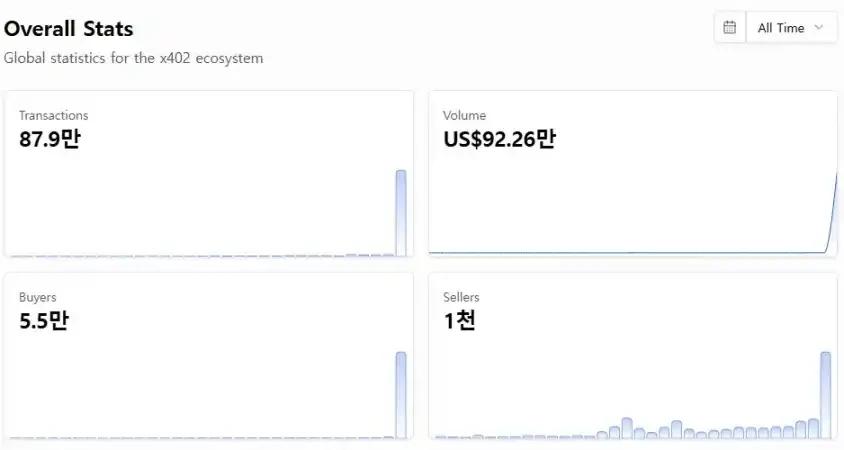
Source: x402scan
Judging by the skyrocketing prices of related tokens and the widespread adoption by major players, x402 has already reached both the hype phase and the infrastructure phase. However, the key question for x402 is whether it can successfully enter the application phase.
According to x402scan data, approximately 55,000 buyers have initiated 879,000 transactions with 1,000 sellers to date. While the number of transactions alone seems impressive, the total transaction value is only approximately $923,000 USD—a scale that suggests x402 is still a long way from reaching the "application stage."
Key conditions for entering the application stage
What conditions must x402 meet to enter the application stage? The most frequently mentioned core factors are "consumer psychology" and "trust system." Even practitioners like me who have long followed x402, while accepting AI agents making recommendations in business scenarios, still have concerns about fully entrusting funds to AI agents.
Currently, even the most advanced large-scale language models occasionally output erroneous information or unexpected results. From a psychological perspective, consumers find it difficult to trust AI agents developed based on such models to process payment transactions. In fact, an Accenture survey of financial institutions revealed that 87% of respondents identified "customer distrust of AI payment systems" as a core issue, and 78% expressed concern that "AI robots could make unauthorized payments or engage in fraud."
The second key factor is the current state of enterprise infrastructure. Accenture data shows that 85% of financial institutions say their existing legacy systems are unable to adapt to the demands of large-scale intelligent payments. The lack of systems to address fraudulent transactions in intelligent payments is one of the main obstacles hindering the industry from entering the adoption phase.
In summary, for x402 to enter the application phase, companies must build optimized systems adapted for intelligent commerce and cultivate consumer trust in these systems. However, both infrastructure development and consumer mindset shifts require significant time—thus, the x402 adoption phase may take longer than expected.
Significance for the blockchain industry
Gartner predicts that by 2030, AI agents will influence $30 trillion in purchases. Although the AI agent payment market is still in its early stages, the x402 protocol has demonstrated its potential to become an industry standard—as evidenced by the adoption of x402 by tech giants such as Google, Anthropic, and Cloudflare for AI agent payment services.
As the x402 ecosystem becomes more active, what changes will the crypto market see? A very likely prediction is that the recent surge in x402-related tokens will be difficult to sustain. Since the rise of the "crypto + AI" field, the field has gradually developed into a meaningful concept and has seen the emergence of numerous innovative initiatives. However, historically, the price performance of small project tokens and meme coins that skyrocketed during the initial hype period has generally been disappointing.
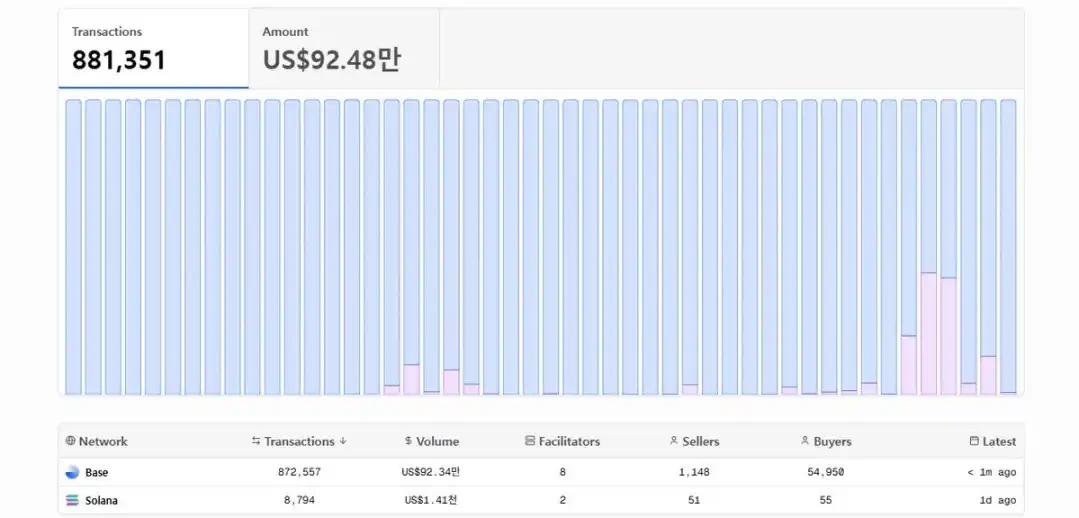
Source: x402scan
The clear value x402 brings to the blockchain industry is that all AI payments will be conducted on blockchain networks. Currently, most transactions occur on the Base network, with a smaller number on the Solana network. However, the x402 protocol was designed from the outset to be blockchain-agnostic, adapting to any blockchain network. This means that as the x402 ecosystem expands, payment activity will no longer be limited to Base and Solana, but will instead span a wider range of blockchain networks, driven by supply and demand between buyers and sellers.
Smart commerce is an inevitable and massive market for the future, and all payments will ultimately be conducted through the x402 protocol on the blockchain. Following stablecoins, the blockchain industry will have found its second global "product-market fit" (PMF) through x402.






